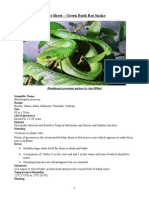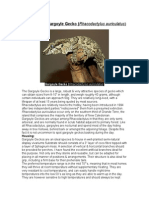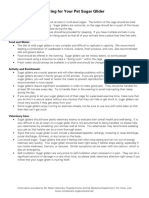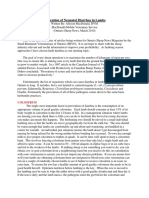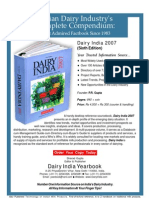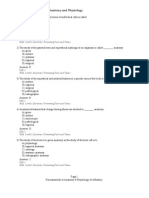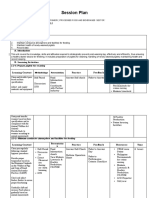Gouldian Finch
Gouldian Finch
Uploaded by
Muhammad Akif Ali AtifCopyright:
Available Formats
Gouldian Finch
Gouldian Finch
Uploaded by
Muhammad Akif Ali AtifCopyright
Available Formats
Share this document
Did you find this document useful?
Is this content inappropriate?
Copyright:
Available Formats
Gouldian Finch
Gouldian Finch
Uploaded by
Muhammad Akif Ali AtifCopyright:
Available Formats
GOULDIAN FINCH
Latin Name: Chloebia gouldiae
INTRODUCTION
Gouldian finches are native to Northern Australia. Their natural habitat is
the tropical savannah woodland. These birds select open plains with
dispersed groups of tall trees or choose to stay at the fringes of mangroves
and thickets. They always tend to be near the water. It is a migratory
species, moving south in the rainy season and reappearing in the northern
regions for the dry months.
Due to the fact that they are now threatened because of illegal trappings
and also because of the invasion of humans into their habitats, the number
of gouldian finches in the wild
has drastically dropped. Its
own beauty seems to be
another cause of this danger
status because of its
ensnarement for aviculture
trade, and fire is also listed as
a jeopardising agent to their
natural populations. A
massive protection scheme is
now under way and with
assistance from the public,
this bird can be maintained
from total extinction. At least,
it can be considered secure in
captivity as a result of it being
one of the most prized aviary
birds in the world.
The gouldian is truly a wonderful bird bred in a wide variety of colours
which never cease to amaze. They are quite sturdy birds but can become
stressed quite easily especially during travel. Gouldian finches are much
more difficult to care for and breed than other types of exotic finches. So,
PDF created with FinePrint pdfFactory trial version http://www.fineprint.com
they are generally not recommended for the novice bird breeder who has
little or no experience with birds.
DESCRIPTION
The Gouldian finch is between 13 and 14
cm long. The three main types of gouldian
finches that are commonly bred are the
black-headed, the red-headed and the
yellow-headed gouldian, with the black-
headed normal gouldian being the most
common bird found in the wild. There are
three main chest band colours which are
purple, which is considered the normal
colour, white and lilac. Body colours vary
from the green of the normal coloured bird
to yellow, blue, or silver. It is a relatively
quiet bird and its song cannot be heard
over long distances.
HOUSING
These finches should be kept in one or more pairs to satisfy their need for
social contact. They will do well in both a mixed aviary as well as cage
setups, both of which should be as spacious as possible. Maintenance of
a certain temperature is extremely important for the gouldian finch and so,
the use of an outdoor aviary during the colder months is not
recommended. Different authors state that the humidity level should be
maintained at or above 55 percent but not to exceed 70 percent. So, the
use of a humidifier or dehumidifier, whichever is the case, is
recommended. Cold, damp or windy locations are to be avoided at all
costs.
SEXING
The standard normal male gouldian finch has a grass green back with a
purple breast. The breast and belly colours are usually used to determine
sex. Males will have a brighter and darker colour of purple on the chest
and the yellow of the belly will be darker and more intense when compared
PDF created with FinePrint pdfFactory trial version http://www.fineprint.com
with the female. The green back
colour and the light blue around the
face mask are also darker. All these
colours are quite brilliant. The beak
is an ivory colour with either a red
or yellow tip, although this can vary
depending on which mutation of
gouldian one has. The male also
has a noticeable longer centre tail
feather when compared with that of
the female. The males will also sing
a nearly inaudible song and they
will usually begin to sing long
before they have completed their
first moult.
The female has the same colourings as the male but paler in comparison
and she generally gets a dark beak when in breeding condition. The
young birds of both sexes resemble a hen bird with no head or chest
colours. One will have to wait until they have completed their first moult to
be able to distinguish between them. Their heads, sides and necks are
ashy-grey changing to olive green on the backs, wings and tail feathers.
BREEDING
The gouldian finch will generally breed towards the latter part of the year,
although it is not out of the norm to breed at
other times. When the birds come into
breeding condition, one will notice certain
physical changes. The cock will stand
upright on his perch sporting a white beak,
which would have gained a red or yellow tip
by now. It will sing heartily, attracting as
much attention as possible, while the other
birds around him will be listening intently.
Gouldian finches do prefer to choose their
own mate and at times do not breed if the
male and female birds do not have a liking
to each other. In a compatible pair, the
PDF created with FinePrint pdfFactory trial version http://www.fineprint.com
cock will approach the hen and start to sing. The male will then dance in
front of the female, actually jumping and leaving the branch in the
process. The female will twitch her tail towards her mate in response.
Then, the nest building begins. The birds seem to prefer mating inside the
nest box, and the eggs usually appear a short while afterwards.
These lay surprisingly large clutches of eggs. In fact, on average they lay
between 5 and 8 eggs, which are white in colour. The pair share
incubation duties during the day but quite often the male will stay outside
during the night. At times, a
clutch of eggs isn’t incubated well
and so it has to be fostered to
Bengalese finches. After about
13 or 14 days of incubation, the
young being to hatch. They are all
pink and lack of fuzz. Some
gouldian finches are notorious
chick tossers; they incubate well
but toss out the young soon after
hatching, which will then have to
be fostered to Bengalese finches.
The chicks of the gouldian finch
are easily identified by the light reflecting nodes at the corners of their
mouth. Both parents take on the role of feeding the chicks. After about 10
to 14 days, the female begins to sleep outside the box.
The chicks fledge at about 22 - 25 days.
Young gouldian finches are somewhat dull
in colour and do not show their true beauty
until they have completed their first moult.
They are dusky green with a cream belly,
but this colouring depends on the type of
gouldian one is breeding. The parents will
continue to feed the chicks for an additional
2 - 3 weeks. The young birds are normally
separated from their parents at around 43
days old. One must always check
beforehand that they are eating well
because when they are moved to a
separate cage, the stress may cause them
to stop eating. Moult will take place at
PDF created with FinePrint pdfFactory trial version http://www.fineprint.com
about 4 - 6 months and it can take up to 9 months for a juvenile to fully
moult into adult plumage. During this critical time, it is good to give the
birds a diet richer in protein.
NESTING MATERIAL
Gouldian finches have no difficulty in raising young in either small cages or
planted aviaries. They should be given the standard finch box, which has
an entrance at the top. This allows them to get down low in the box and
hide, thus feeling safer. They are not master nest builders and will use
mostly rough materials with softer materials being ignored or even ejected
if placed in the box. At times, no nesting material is used at all. The male
will take on the majority of the nest building chores by bringing in material
to the nest. The female will rearrange the material to her liking.
DIET
The gouldian finch should be offered a mixture of canary seed, various
types of millet and niger seed, all of which should be available in a good
quality Foreign Finch Mix.
From left to right : Canary seed, Yellow millet, White millet, Red millet, Japanese millet,
Panicum yellow, Panicum red and Niger seed.
A good mixture of seeds is not completely sufficient to insure a balanced
diet. So, they must also be given egg food, greens, mealworms and
soaked millet. Grit and calcium in the form of crushed egg and oyster
shells should always be available to them. Charcoal is a very good
digestion balancer and should also be made available. Gouldian finches
PDF created with FinePrint pdfFactory trial version http://www.fineprint.com
also seem to have a greater dietary need for iodine than other birds.
Insufficient iodine in their diet often results in a loss of feather around their
head but once the iodine intake is increased, the feathers will most likely
regrow. Fresh clean water should be present at all times in any birds’
cage.
SPECIAL PRECAUTIONS
Gouldian finches seem particularly susceptible to Air Sac mites. It is a
highly contagious parasite which invades the respiratory system and which
will eventually cause the bird’s death. An infected bird seems lethargic
and has difficulty in breathing, but a sure sign of this parasite is the clicking
sound the bird makes while breathing. A drop of medication (ask local
veterinarian for advice) on the bare skin between the shoulder blades
should do the job.
REFERENCES
Fulmer, R. Gouldian Finches: A Basic Introduction [On-line]
Available: http://www.finchworld.com/gouldpage.html
Gouldian Finch [On-line]
Available:
http://www.honoluluzoo.org/gouldian_finch.htm
Levitt, B. & Rushall, D. (2003) About Gouldian Finches [On-line]
Available: http://www.gouldianfinch.co.uk
March, B. & March, D. (2003) The Basic Requirements [On-line]
Available: http://www.gouldianfinch.co.uk
Marshall, R. Dr & Sammut, J. (1991) A Guide to…Gouldian Finches,
Australian Bird Keeper, Australia.
PDF created with FinePrint pdfFactory trial version http://www.fineprint.com
Vriends, M. M. (1991) Gouldian Finches, Barron’s Educational Series, Inc.,
Hong Kong
What to feed them [On-line]
Available: http://www.gouldianfinch.co.uk
LINKS
http://www.gouldianfinch.co.uk/pages/home.html
PDF created with FinePrint pdfFactory trial version http://www.fineprint.com
You might also like
- Eibl Eibesfeldt Human EthologyDocument23 pagesEibl Eibesfeldt Human EthologyCarlosA31100% (1)
- Beyond Diet Meal PlansDocument72 pagesBeyond Diet Meal Plansintankamaruddin100% (3)
- Tragopan 1314Document37 pagesTragopan 1314rkalsiNo ratings yet
- Casquehead Iguana PDFDocument3 pagesCasquehead Iguana PDFJohn GamesbyNo ratings yet
- Care Sheet - Diones Rat SnakeDocument2 pagesCare Sheet - Diones Rat SnakeJohn GamesbyNo ratings yet
- Care Sheet - Halmahera Giant Gecko (Gehyra Marginata)Document2 pagesCare Sheet - Halmahera Giant Gecko (Gehyra Marginata)John Gamesby100% (1)
- Care Sheet - Green Bush Rat SnakeDocument2 pagesCare Sheet - Green Bush Rat SnakeJohn GamesbyNo ratings yet
- Unit-1: Compiled By: Shambhu Kumar Mishra (B. Sc. 3 Year, 2 Half)Document113 pagesUnit-1: Compiled By: Shambhu Kumar Mishra (B. Sc. 3 Year, 2 Half)Prakriti Sahitya ManchNo ratings yet
- Galah CockatooDocument2 pagesGalah CockatooColin LewisNo ratings yet
- Dragonlance - Anthologies 1 - The Dragons of Krynn PDFDocument191 pagesDragonlance - Anthologies 1 - The Dragons of Krynn PDFmartin_corker100% (2)
- Gouldian Finch Care and BreedingDocument3 pagesGouldian Finch Care and BreedingJoseNo ratings yet
- Care Sheet - Long-Nosed Snake (Rhinocheilus Lecontei)Document2 pagesCare Sheet - Long-Nosed Snake (Rhinocheilus Lecontei)John GamesbyNo ratings yet
- Centipede and Millipede CareDocument5 pagesCentipede and Millipede CareTurel626No ratings yet
- Bull and RamDocument23 pagesBull and RamAde75% (4)
- Care Sheet - Persian Rat SnakeDocument2 pagesCare Sheet - Persian Rat SnakeJohn Gamesby0% (1)
- Care Sheet - Black Rat SnakeDocument2 pagesCare Sheet - Black Rat SnakeJohn GamesbyNo ratings yet
- Parelhoenders in Handbook of The Birds of The World 01Document21 pagesParelhoenders in Handbook of The Birds of The World 01Alyssa LeonidoNo ratings yet
- Care Sheet - Gargoyle GeckoDocument4 pagesCare Sheet - Gargoyle GeckoJohn GamesbyNo ratings yet
- BloatDocument57 pagesBloatHari Krishnaa AthotaNo ratings yet
- Metabolic Diseases in Zoo and Wild AnimalsDocument40 pagesMetabolic Diseases in Zoo and Wild AnimalsAbhishek MandaranaNo ratings yet
- Reptiles - Snakes - Python Fact SheetDocument2 pagesReptiles - Snakes - Python Fact SheetUwaisNo ratings yet
- Zebra Finches (2011) PDFDocument6 pagesZebra Finches (2011) PDFRicardo SantosNo ratings yet
- Nervous System of RabbitDocument27 pagesNervous System of RabbitDr. Valentina Claudet PNo ratings yet
- Mutation I : LorikeetsDocument62 pagesMutation I : LorikeetsIonut Gabriel100% (1)
- Care Sheet - Great Plains Rat SnakeDocument2 pagesCare Sheet - Great Plains Rat SnakeJohn GamesbyNo ratings yet
- 2 UrinarySystemDocument83 pages2 UrinarySystemLemuel Lagasca Razalan IVNo ratings yet
- Snakes Biting MechanismDocument7 pagesSnakes Biting Mechanismnancy sharmaNo ratings yet
- Care Sheet - Emma Gray's Forest LizardDocument2 pagesCare Sheet - Emma Gray's Forest LizardJohn Gamesby100% (1)
- Care Sheet - Forest DragonDocument2 pagesCare Sheet - Forest DragonJohn GamesbyNo ratings yet
- Manual For The Treatment of Poultry DiseaseDocument75 pagesManual For The Treatment of Poultry DiseaseAzwar ChishtiNo ratings yet
- KS2 - Design A Zoo With A Budget 2015 - EDUCATIONDocument9 pagesKS2 - Design A Zoo With A Budget 2015 - EDUCATIONtoha putraNo ratings yet
- Animal FactsDocument13 pagesAnimal FactsLucy WalcottNo ratings yet
- Lion Care Manual 20121Document144 pagesLion Care Manual 20121salman672003No ratings yet
- UltrasonographyDocument21 pagesUltrasonographyChecko LatteNo ratings yet
- Vetavora 25 - Nutrisi Dan Husbandry ParrotDocument31 pagesVetavora 25 - Nutrisi Dan Husbandry ParrotJulia SandieNo ratings yet
- Australian Birdkeeper Volume 35 Issue 6 December 2022 January 2023Document60 pagesAustralian Birdkeeper Volume 35 Issue 6 December 2022 January 202311 - Bạch Phan Đông Khải - 10C100% (1)
- Sheep: For Other Uses, SeeDocument5 pagesSheep: For Other Uses, SeesevenNo ratings yet
- BIRDS ActivityDocument13 pagesBIRDS ActivityMudasir SalikNo ratings yet
- Parasites in GoatsDocument57 pagesParasites in GoatsMez NacerNo ratings yet
- Caring For Your Sugar GliderDocument3 pagesCaring For Your Sugar GliderJohnErickDonesNo ratings yet
- Care Sheet - Cameroon Sailfin ChameleonDocument2 pagesCare Sheet - Cameroon Sailfin ChameleonJohn GamesbyNo ratings yet
- Taurine and Zoo Felids Considerations of Dietary and Biological Tissue Concentrations 2007 Zoo BiologyDocument15 pagesTaurine and Zoo Felids Considerations of Dietary and Biological Tissue Concentrations 2007 Zoo BiologygabrielwerneckNo ratings yet
- Chapter 2 Snakes of Papua New GuineaDocument23 pagesChapter 2 Snakes of Papua New GuineaIrfan Haidar BasyirNo ratings yet
- Canine Ehrlichiosis With Uveitis in A Pug Breed Dog: Case StudDocument2 pagesCanine Ehrlichiosis With Uveitis in A Pug Breed Dog: Case StudDR HAMESH RATRENo ratings yet
- OstrichDocument2 pagesOstrichTamiru Legesse100% (1)
- Sugar Gliders: DescriptionDocument7 pagesSugar Gliders: DescriptionKumar NavinNo ratings yet
- Bovine Rectal PalpationDocument4 pagesBovine Rectal PalpationPalitha AbeysingheNo ratings yet
- Management of Pigeon BirdDocument11 pagesManagement of Pigeon BirdIgwe Fredrick S.No ratings yet
- Why and How To Do FAMACHA Scoring: USDA Sustainable Agriculture Research and Education Program (LNE10-300)Document4 pagesWhy and How To Do FAMACHA Scoring: USDA Sustainable Agriculture Research and Education Program (LNE10-300)Matt MedwayNo ratings yet
- NeoxyvitalDocument2 pagesNeoxyvitaladel malikNo ratings yet
- Be A Rid TrainingDocument8 pagesBe A Rid Trainingblazerman3No ratings yet
- Snake Pictures Types of Snakes (Non-Venomous) Scientific NameDocument4 pagesSnake Pictures Types of Snakes (Non-Venomous) Scientific NameLamborghini Cili BerapiNo ratings yet
- 12-Fancy Birds RearingDocument45 pages12-Fancy Birds RearingAnonymous sBJu38BqNo ratings yet
- Prevention of Neonatal Diarrhea in LambsDocument3 pagesPrevention of Neonatal Diarrhea in LambsCarol LeslieNo ratings yet
- Care Sheet - Green IguanaDocument6 pagesCare Sheet - Green IguanaJohn GamesbyNo ratings yet
- Canine LeismaniasisDocument60 pagesCanine LeismaniasisIoana GeanăNo ratings yet
- Penguin Care Manual AZA Final 2014Document143 pagesPenguin Care Manual AZA Final 2014cristina_gomh100% (2)
- Care Sheet - Flowered RacerDocument2 pagesCare Sheet - Flowered RacerJohn GamesbyNo ratings yet
- Sun-Conure Care WPCDocument3 pagesSun-Conure Care WPCYuuyuNo ratings yet
- Avian Renal System Clinical ImplicationsDocument19 pagesAvian Renal System Clinical ImplicationsAnais FaveroNo ratings yet
- Endemic BirdsDocument74 pagesEndemic BirdsGEETA BHANDARI100% (1)
- Pigeon Husbandry: General InformationDocument6 pagesPigeon Husbandry: General InformationshachoujosephNo ratings yet
- Home WDocument38 pagesHome WSriram SriramNo ratings yet
- ImmunoglobulinDocument41 pagesImmunoglobulinFarlogyNo ratings yet
- 150 Commonly Misspelled Words: Writing, Reading, and Language Center MC GermantownDocument2 pages150 Commonly Misspelled Words: Writing, Reading, and Language Center MC GermantownAnashe MutambaneshiriNo ratings yet
- Science Form 2: Section A (25 Objective Questions)Document5 pagesScience Form 2: Section A (25 Objective Questions)Seri DaryantiNo ratings yet
- CAT 2022 Slot 3 by CrackuDocument24 pagesCAT 2022 Slot 3 by CrackuSharvendraKarnaNo ratings yet
- MBDDocument4 pagesMBDyvesdrewNo ratings yet
- Dry Extrusion of Full Fat Soybeans PrinciplesDocument38 pagesDry Extrusion of Full Fat Soybeans PrinciplesJohn Honest86% (7)
- p.6 Primary Six Eng Scheme of Work Teacher - AcDocument12 pagesp.6 Primary Six Eng Scheme of Work Teacher - Acmagoolaenock787No ratings yet
- Refleks 4 SBV BirdsDocument4 pagesRefleks 4 SBV BirdsNurl Aina100% (1)
- AAPD Guideline On Management of The Developing Dentition and OcclusionDocument13 pagesAAPD Guideline On Management of The Developing Dentition and OcclusionMaja Maja Bułka100% (1)
- Aeb 202: Structures and Materials - Notes Cattle HousingDocument16 pagesAeb 202: Structures and Materials - Notes Cattle HousingMutuajm100% (3)
- Neanderthal - Living RulesDocument42 pagesNeanderthal - Living RulesemildiaNo ratings yet
- Nina Vera Bontigao Kryslyn Dubduban Diane Librea Kint Jushwa Pable Arianne Pastoriza Zeus SilorioDocument12 pagesNina Vera Bontigao Kryslyn Dubduban Diane Librea Kint Jushwa Pable Arianne Pastoriza Zeus SilorioHANNA JEAN SANTILLAN UBASNo ratings yet
- Scorpions: Collect Fact About Insect - Write Five Fact .Present Your Project To The Class - You Can Use The Key Word InsectsDocument2 pagesScorpions: Collect Fact About Insect - Write Five Fact .Present Your Project To The Class - You Can Use The Key Word Insectsrozalinda hoxhaNo ratings yet
- 10th PT 3Document14 pages10th PT 3Pramod VermaNo ratings yet
- 7A Cells Summary Sheet PDFDocument2 pages7A Cells Summary Sheet PDFSamarth NarediNo ratings yet
- Manhunt!: Adventure Creation HandbookDocument17 pagesManhunt!: Adventure Creation Handbookmadcap01No ratings yet
- All About Me Part 2Document13 pagesAll About Me Part 2shairaairaNo ratings yet
- 2019-08-07 Shooting Times & Country PDFDocument60 pages2019-08-07 Shooting Times & Country PDFRohit Kumar0% (1)
- Communicable Diseases ReviewerDocument12 pagesCommunicable Diseases ReviewerEmy TandinganNo ratings yet
- Bird Book TalkDocument43 pagesBird Book TalkDavid AllenNo ratings yet
- Animal ProtocolDocument2 pagesAnimal ProtocolLuminita Telecan100% (2)
- Dairy India 2007Document4 pagesDairy India 2007Rama Kr M100% (1)
- Communicable DiseaseDocument91 pagesCommunicable DiseaseIrisJillNo ratings yet
- Multiple Choice Questions: Chapter 1 An Introduction To Anatomy and PhysiologyDocument15 pagesMultiple Choice Questions: Chapter 1 An Introduction To Anatomy and Physiologybae sujiNo ratings yet
- Session Plan: Learning OutcomesDocument4 pagesSession Plan: Learning OutcomesJohn James75% (4)
- c2 - Repere În Anatomia CreieruluiDocument12 pagesc2 - Repere În Anatomia CreieruluiElena-Andreea MutNo ratings yet






